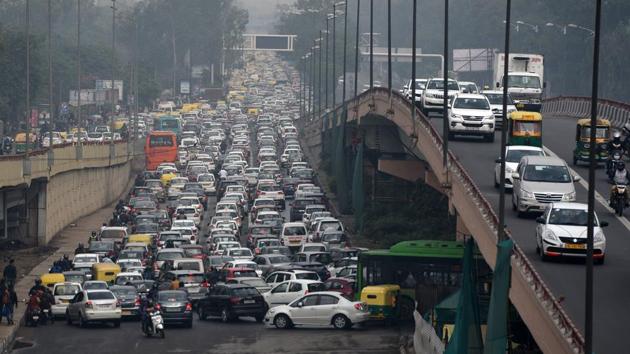Fixing Delhi’s worst traffic congested areas
The Delhi Traffic Police has identified 25 of the most congested small stretches across the city and is preparing dedicated traffic circulation plans for each of them to clear bottlenecks.
The Delhi Traffic Police has identified 25 of the most congested small stretches across the city and is preparing dedicated traffic circulation plans for each of them to clear bottlenecks, according to senior government officials and documents accessed by Hindustan Times.

According to the plan, the rule changes to be implemented in the 25 stretches — each between one and two kilometres long — include making roads one-way, installing pedestrian signals, and changing traffic movement during peak hours, based on the requirement and traffic volume of each stretch.
These stretches have been picked after assessing traffic volume and reduction of average speed during peak traffic hours, said a senior Delhi Traffic Police officer who asked not to be named.
Some of the stretches identified by the department are Paschim Vihar (Jwala Heri Market bus stand to Puri bakery), Rajouri Garden Market (Divine Inn Service Apartment to Marble Market T-point), Lajpat Nagar Market (Gupta Market Road near Pink Line metro station to Lala Lajpat Rai Road), Dabri Mor (Below the Janakpuri flyover to Janakpuri C-II turning), RK Puram sector-12 (Rao Tula Ram Marg to Vasant Enclave T-point, below the flyover) and Lawrence Road (near Legend Footwear to Shri Kumar automobiles), according to the plan document reviewed by HT.
In the 30 days that these stretches were observed by officials from Delhi Traffic Police, it was noted that traffic speed consistently remained under 25km per hour even without taking into account traffic signals, the officer quoted above said.
Sample this: At the busy Lajpat Nagar market commuters commuters now take at least 20 minutes to cross Central Market and exit Lala Lajpat Rai Road, a distance of around three kilometres. Major bottlenecks inside the market and near the metro station gates hinder flow of traffic. During weekends, the travel time increases even more. Traffic police estimates show that once the new plan is applied, the time is likely to be reduced to half.
The officer cited above said the plan has been sent to road-owning agencies such as the Public Works Department (PWD), National Highways Authority of India (NHAI) and the three municipal corporations (north, south and east) to discuss details of how it can be implemented.
“The plan is still at its initial stage. Once we get an approval from these agencies, we will be able to work it out in greater detail,” said a second traffic official aware of the project details. “Smaller stretches are easier to work with; we have also tried to avoid intersections. If we are able show results in these areas, we can go on and include more stretches in the plan.”
The first officer added that the plan is largely on the model of the ITO intersection, where diverting traffic from Deen Dayal Upadhyay Marg towards Vishnu Digamber Marg after 6pm, and allowing traffic coming from the carriageway opposite the Police Headquarters to turn towards Bahadur Shah Zafar Marg has visibly eased congestion on one of Delhi’s busiest junctions. Nearly 300,000 vehicles cross the ITO intersection during the peak traffic hours of morning and evening, according to Delhi Traffic Police estimates.
Though a detailed study is yet to be conducted to determine how much travel time has reduced with the help of the changed traffic plan, traffic police officials said they have observed that the waiting time at the intersection has significantly reduced.
“The traffic plan at ITO is definitely working. We cannot control the volume but we can manage it. This model can be replicated in other parts. However, one solution will not fit all and dedicated traffic plans will have to be worked out for different stretches,” said special commissioner of police (traffic) Taj Hassan.
Traffic experts say drawing dedicated traffic plans for choke points is the only way to ease traffic in the city.
“Whenever you drive through a congested road you might have noticed that it is very rare that the entire road is clogged. There would always be problem points, where traffic gets stuck. If agencies join hands to tackle these points, we could see a difference,” said Subhash Chand, head of traffic engineering and safety division at the Central Road Research Institute (CRRI).

Stay updated with all top Cities including, Bengaluru, Delhi, Mumbai and more across India. Stay informed on the latest happenings in World News along with Delhi Election 2025 and Delhi Election Result 2025 Live, New Delhi Election Result Live, Kalkaji Election Result Live at Hindustan Times.
Stay updated with all top Cities including, Bengaluru, Delhi, Mumbai and more across India. Stay informed on the latest happenings in World News along with Delhi Election 2025 and Delhi Election Result 2025 Live, New Delhi Election Result Live, Kalkaji Election Result Live at Hindustan Times.





